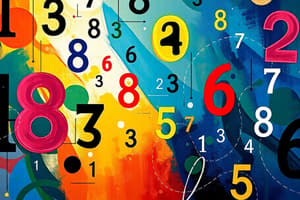Podcast
Questions and Answers
Which of the following is the greater ratio: 3:4 and 4:5?
Which of the following is the greater ratio: 3:4 and 4:5?
- 3:4
- 4:5 (correct)
- Both (A) & (B)
- None of the above
The inverse of a matrix exists when:
The inverse of a matrix exists when:
- |A| = 1
- |A| = 0
- |A| ≠ 0 (correct)
- |A| ≠ 1
Find the value of ⁶C₁ + ₂C₁.
Find the value of ⁶C₁ + ₂C₁.
- 7
- 9
- 8
- 10 (correct)
For matrix addition, which is true?
For matrix addition, which is true?
If x:7 :: 5:4, find the value of x:
If x:7 :: 5:4, find the value of x:
In an examination, 50 candidates passed and 10 candidates failed. What is the ratio of passed to failed candidates?
In an examination, 50 candidates passed and 10 candidates failed. What is the ratio of passed to failed candidates?
What sum will amount to Rs. 33,075 in two years at 5% per annum compound interest?
What sum will amount to Rs. 33,075 in two years at 5% per annum compound interest?
What will be the simple interest on Rs. 8,000 for 6 years at an annual rate of 5%?
What will be the simple interest on Rs. 8,000 for 6 years at an annual rate of 5%?
Find the value of ¹¹P₁.
Find the value of ¹¹P₁.
In how many ways can the word 'BANKER' be rearranged?
In how many ways can the word 'BANKER' be rearranged?
Formula for calculating compound amount when interest is compounded annually:
Formula for calculating compound amount when interest is compounded annually:
The ratio between the number of boys and girls in a class is 1:3. If the number of boys is 11, what is the total number of students in the class?
The ratio between the number of boys and girls in a class is 1:3. If the number of boys is 11, what is the total number of students in the class?
In how many ways can 8 persons sit around a circular table?
In how many ways can 8 persons sit around a circular table?
If 36 men can do a certain piece of work in 25 days, how many days will 15 men take to do it?
If 36 men can do a certain piece of work in 25 days, how many days will 15 men take to do it?
Value of 1°C₁ is equals to:
Value of 1°C₁ is equals to:
Aman took a loan of ₹18,000 for 5 years at simple interest. If the total interest paid is Rs. 3600, what is the rate of interest per annum?
Aman took a loan of ₹18,000 for 5 years at simple interest. If the total interest paid is Rs. 3600, what is the rate of interest per annum?
How many words can be made by 25 consonants and 5 vowels where it contains 2 consonants and 3 vowels?
How many words can be made by 25 consonants and 5 vowels where it contains 2 consonants and 3 vowels?
The tabular form of the set P={x:x∈N, x < 6} will be:
The tabular form of the set P={x:x∈N, x < 6} will be:
Log₁₀¹⁰ =?
Log₁₀¹⁰ =?
If A = {1, 2, 3, 4, 5}, B = {4, 5, 6, 7, 8}, C = {7, 8, 9, 10}, D = {10, 11, 12, 13, 14}, then A∪B =?
If A = {1, 2, 3, 4, 5}, B = {4, 5, 6, 7, 8}, C = {7, 8, 9, 10}, D = {10, 11, 12, 13, 14}, then A∪B =?
Log (1+2+3) =?
Log (1+2+3) =?
If A = {1, 2, 3, 4, 5}, B = {2, 4, 6, 8}, and C = {3, 5, 7}, then: A∪(B∪C) =?
If A = {1, 2, 3, 4, 5}, B = {2, 4, 6, 8}, and C = {3, 5, 7}, then: A∪(B∪C) =?
A man bought a watch for Rs. 80/- and sells it for Rs. 120. What will be the profit percentage?
A man bought a watch for Rs. 80/- and sells it for Rs. 120. What will be the profit percentage?
Flashcards
Ratio
Ratio
A comparison of two quantities with a specific order.
Matrix Inverse
Matrix Inverse
The inverse of a matrix exists only if its determinant is not zero.
Combinations
Combinations
Calculating the number of ways to choose items from a set, without regard to order.
Matrix Addition
Matrix Addition
Signup and view all the flashcards
Permutations
Permutations
Signup and view all the flashcards
Compound Interest
Compound Interest
Signup and view all the flashcards
Simple Interest
Simple Interest
Signup and view all the flashcards
Circular Permutations
Circular Permutations
Signup and view all the flashcards
Work and Time
Work and Time
Signup and view all the flashcards
Logarithms
Logarithms
Signup and view all the flashcards
Sets
Sets
Signup and view all the flashcards
Profit Percentage
Profit Percentage
Signup and view all the flashcards
Tabular form of a set
Tabular form of a set
Signup and view all the flashcards
Logarithmic Properties
Logarithmic Properties
Signup and view all the flashcards
Factorials
Factorials
Signup and view all the flashcards
Exclamation Mark (!)
Exclamation Mark (!)
Signup and view all the flashcards
Arithmetic
Arithmetic
Signup and view all the flashcards
Matrix
Matrix
Signup and view all the flashcards
Determinant of a Matrix
Determinant of a Matrix
Signup and view all the flashcards
Union of Sets (A∪B)
Union of Sets (A∪B)
Signup and view all the flashcards
Intersection of Sets (A∩B)
Intersection of Sets (A∩B)
Signup and view all the flashcards
Matrix Inversion
Matrix Inversion
Signup and view all the flashcards
Compound Interest Formula
Compound Interest Formula
Signup and view all the flashcards
Simple Interest Formula
Simple Interest Formula
Signup and view all the flashcards
Study Notes
Arithmetic Aptitude - BBA Examination
- Exam Code: BBA-501
- Total Questions: 100
- Maximum Marks: 75
- Time Allowed: 2 Hours
- All questions carry equal marks.
- Candidates need to answer all questions on the OMR Answer Sheet provided, not on the question booklet.
Key Concepts
- Ratio: Demonstrated through the example of 3:4 and 4:5, where the problem asks which is the greater ratio.
- Matrix Inverse: The inverse of a matrix exists only when the determinant of the matrix is not equal to zero (|A| ≠ 0).
- Combinations: Demonstrated through the example ⁶C₁+ ₂C₁, where the problem asks to find the value of the expression.
- Matrix Addition: Matrix addition follows the commutative, associative, and cancellation laws.
- Permutations: Illustrated by calculating ¹¹P₁, which represents the number of ways to arrange 11 items in a line.
- Compound Interest: Defined by the formula Amount = P[1 + (r/100)]^t, where 'P' is the principal, 'r' is the rate of interest per annum, and 't' is the time period.
- Simple Interest: Calculated using the formula Simple Interest = (P * R * T) / 100, where 'P' is the principal, 'R' is the rate of interest per annum, and 'T' is the time period.
- Circular Permutations: Solved by using the formula (n-1)!, where 'n' is the number of objects being arranged in a circle.
- Work and Time: Explored through the example of 36 men completing a task in 25 days, asking the time required for 15 men to complete the same task.
- Logarithms: Defined by the equation log a b = c, where 'a' is the base, 'b' is the argument, and 'c' is the exponent.
- Sets: Covered by exploring the union of sets A∪B and A∪(B∪C).
- Profit Percentage: Calculated as (Selling Price - Cost Price) / Cost Price * 100.
- Tabular form of a set: Demonstrated by representing the set P={x:x∈N, x < 6} in tabular form.
- Logarithmic Properties: The example Log₁₀¹⁰ illustrates the principle that log a a = 1.
- Factorials: Explained through the problem: In how many ways can the word "BANKER" be rearranged?, where the answer is 6!, representing the number of ways to arrange 6 distinct items.
Studying That Suits You
Use AI to generate personalized quizzes and flashcards to suit your learning preferences.




